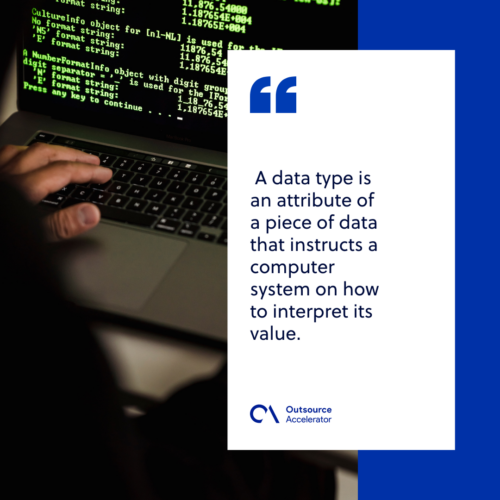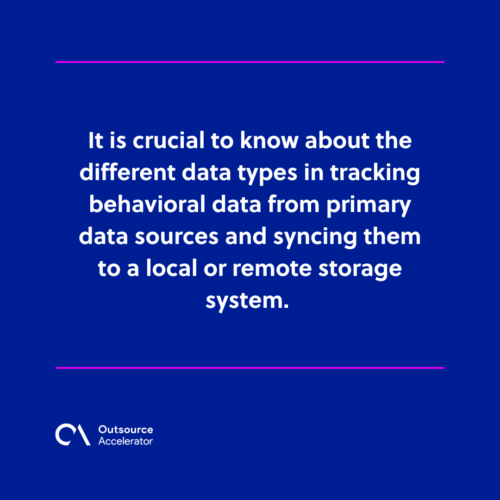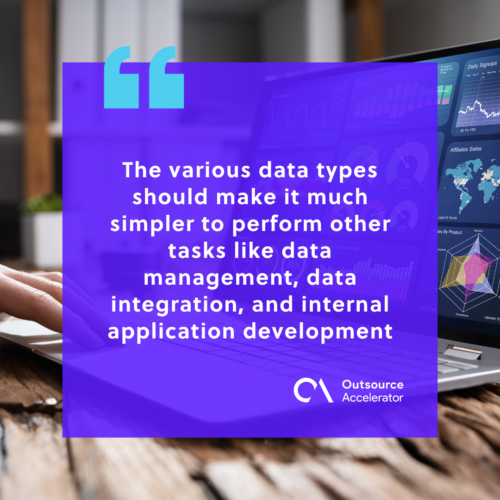Get to know the different data types and their importance

The core of data science is experimentation with both organized and unorganized data. These types of data are the fuel that can steer a business in the correct direction or, at the very least, offer useful insights.
Knowledgeable insights may then be used in planning future campaigns, organizing the introduction of new products and features of a business, or conducting various experiments.
Understand the various data types to help you perform various business tasks in the most efficient way through this article.
What are data types?
A data type is an attribute of a piece of data that instructs a computer system on how to interpret its value. It also classifies different mathematical, relational, and logical operations that can be performed on the computer without producing an error.

The importance of knowing data types
It is important to grasp all of the various data types when the main issue of your business is knowing how to use consumer data.
It is crucial to know about the different data types in tracking behavioral data from primary data sources and syncing them to a local or remote storage system. It begins with the development of a data-tracking strategy.
Specifying the data type of each property in the tracking plan makes the instrumentation process much more efficient, lessening errors when determining which events to track and what attributes to gather.
Moreover, as a data-driven professional, it is likely that you will use surveys to collect data from your clients at every stage of the client relationship. The survey questions you ask may be open-ended or include predefined options.
With that, you must identify a property name and its data type for each field in your survey before storing the results in a database or a third-party system. The value entered is stored in the property name, and the data type verifies that the value is what was intended.
By doing this, data becomes consistent, which facilitates data analysis and activation.

11 Common data types to know
Data types can sometimes be confused with entity data and event data, the two categories of data generally referred to as customers.
Here are 11 common data types you must be familiar with in business:
1. Integer (int)
An integer is the most typical type of numeric data used to store numbers without a fractional component.
Examples: -606, 0, 404
2. Floating Point (float)
As with monetary values, a floating point is a numeric data type designed to record numbers that may include a fractional component.
Examples: 505.05, 0.4, 202.00
3. Character (char)
Character refers to a single letter, digit, punctuation mark, symbol, or blank space.
Examples: a, 1, !
4. String (str or text)
A string is a sequence of characters and the most often used data type to store text. It can also have numbers and symbols, although they are still referred to as text.
The most common way to save a phone number is as a string (+1-222-333-4444), but it can also be kept as an integer (9998887777).
Examples: word, +1-999-888-444
5. Boolean (bool)
Boolean stands for the concepts of true and false. A boolean value can occasionally also be represented as 0 (for false) and 1 while working with the boolean data type (for true).
Examples: 0 (false), 1 (true),
6. Enumerated type (enum)
The enumerated type has a small set of predetermined, distinct values that may be compared and assigned to an enumerated data type variable. These values are also referred to as elements or enumerators.
An enumerated type may have text-based or numerical values. The boolean data type is actually an enumeration of the values true and false that have been pre-defined.
If red and blue are the enumerators, for instance, an enumerated type variable called color can only be given one of the two values.
The variable color will store either red or blue if you are asked to state your preferences and are given the option of selecting one of the two colors from a dropdown menu.
Values can be saved and retrieved using enumerated types as strings or numeric indices (0, 1, and 2).
Examples: red (0), blue (1)
7. Array
An array often called a list, is a type of data that contains a number of elements in a particular sequence, usually all of the same type.
The structure of data held by an array is known as an array data structure because an array stores several items or values.
The total number of elements in an array represents the length of an array, and each element of an array can be obtained using an integer index (0, 1, 2,…).
Red, blue, and yellow, for instance, can all be stored in an array variable called colors. The three values are represented by the indices 0 for red, 1 for blue, and 2 for yellow, and the array’s length is 3. (since it contains three elements).
Keeping with the color preference example, the variable color will keep all three components if you are prompted to select one or more of the three colors, and you happen to like them all.
Examples: red (0), blue (1), yellow (2), green (3)
8. Date
The format used to store dates is commonly YYYY-MM-DD, also known as the ISO 8601 syntax.
Example: 2000-03-04
9. Time
The format used to store times is hh:mm:ss. The time elapsed or the gap between two occurrences, which may be more than 24 hours, can also be stored in addition to the current time of day.
Example: 10:28:59
10. Datetime
Datetime combines both the elements of date and time and keeps a value in the YYYY-MM-DD hh:mm:ss format.
Example: 2000-03-04 10:28:59
11. Timestamp
Timestamp typically shows the number of seconds since midnight on January 1st (00:00:00 UTC), expressed in Unix time.
Computer systems often use it to record events’ exact date and time, down to the last few seconds, in a way that is unaffected by time zones.
In contrast to DateTime, the timestamp does not change based on where you are in the world.
Example: 00:00:00 UTC

Applying different data types to your processes
Your understanding of the various data types should make it much simpler to perform other tasks like data management, data integration, and internal application development (using no-code or low-code tools).
By combining domain knowledge in programming, mathematics, and statistics to produce fresh insights and make sense of massive amounts of data, making sense of data science by understanding the different data types can help in various business needs.
Since it involves the gathering, storing, sorting, and assessing of data, identifying data types can help you make data-driven decisions as it explains how digital data transforms organizations and enables you to make more informed and crucial business plans.







 Independent
Independent




